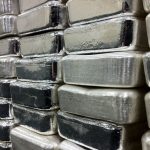Gold fell to a five-week low and is headed to its worst weekly performance in more than two months on broad expectations that the Federal Reserve will trim its bond purchases at next weeks FOMC meeting. Fading fears that the U.S. will launch a punitive military attack against Syria curbed safe haven demand for the metal after yesterday U.S. Secretary of State John Kerry began a two-day meeting with his Russian colleague Sergei Lavrov in Geneva.
On the Comex division of the New York Mercantile Exchange, gold for December delivery declined by 0.93% to $1 318.20 per troy ounce at 7:28 GMT. Futures fell to a five-week low of $1 307.90 per ounce earlier in the session, while days high stood at $1 330.70 an ounce. The precious metal plunged 2.7% on Thursday and is headed to posting its worst weekly performance in more than two months with a 5.3% decline so far.
Gold extended its steep decline amid expectations that today’s likely upbeat U.S. data will reinforce the case that the Federal Reserve will begin trimming its monetary easing program after next week’s Federal Open Market Committee meeting. To be released today, August’s retail sales are projected to have increased by 0.5% following a 0.2% jump in July. Core retail sales likely rose by 0.3%. Producer inflation (Producer Price Index) should have risen by 0.2% on a monthly basis and 1.3% from a year earlier. Core PPI is expected to have gained 0.1% from July and 1.3% from August 2012. The preliminary reading of the Reuters/University of Michigan Confidence index is projected to have declined by 0.1 to 82.0.
According to a Bloomberg survey conducted last Friday, the central bank will trim its monetary stimulus by $10 billion after the meeting. Goldman Sachs analysts shared the same prediction.
Meanwhile, gold traders turned most bearish since June on both speculation over QE tapering incoming and tension in Syria receding. Out of twenty-five analysts survey by Bloomberg, fifteen expected prices to extend their decline into next week. Seven wagered that the metal will gain, while three remained neutral. This was the largest number of bears since June 21.
Middle East tension fades
Gold prices rose to a 3 1/2-month high on August 28 as fears that a U.S.-led military intervention in the Syrian civil war will lead to a broad conflict spurred safe haven demand. The precious metal however erased most of its geopolitical premium and is back on track to post its first annual decline in 13 years with a 22% loss so far this year.
Tension began to ease this week after on Tuesday Foreign Minister Walid al-Muallem said during a trip to Moscow that Syria had accepted Russia’s proposal for granting international control over its chemical weapons as a way for peacefully resolving the conflict with the U.S. and averting military intervention.
President Barack Obama asked Congress in a televised address to the nation later on Tuesday to delay voting for authorization of military action against Syria, seeking a diplomatic resolution to the problem. “It’s too early to tell whether this offer will succeed, and any agreement must verify that the Assad regime keeps its commitments,” Obama said. “The initiative has the potential to remove the threat of chemical weapons without the use of force, particularly because Russia is one of Assad’s strongest allies.”
U.S. Secretary of State John Kerry and his Russian colleague Sergei Lavrov are due to continue their talks on the Syrian conflict today. Yesterday, the two and other U.S. and Russian officials met in Geneva to begin discussing Moscow’s plan to bring Syria’s chemical arsenal under international control. Kerry however said that military action may still be needed if diplomacy fails. The two diplomats will discuss the securing, transporting and destroying Syria’s chemical weapons in today’s talks. Meanwhile, Syrian President Bashar al-Assad said that the U.S. must cease threatening with military intervention in the country’s civil war and stop arming rebels in return for relinquishing control Syria’s chemical weapons.
Georgette Boele, a commodities strategist at ABN Amro Group NV in Amsterdam, said for Bloomberg: “With Syria there may be some volatility going forward but I doubt if it will have an impact unless you have huge escalation. If the Fed doesn’t surprise majorly in one way or another and the sentiment improvement continues, there’s no reason to be in gold.”
Elsewhere on the precious metals market, silver declined, while platinum and palladium posted minor daily gains. Silver futures for December delivery fell by 1.23% to $21.877 per ounce at 7:50 GMT and ranged between days high and low of $22.182 and $21.705 an ounce respectively. The metal has fallen 8.4% so far and is headed to its worst performance since the week ended June 21. Meanwhile, platinum October futures rose by 0.02% to $1 443.05 an ounce. Futures held in range between days high of $1 451.65 and a five-week low at $1 433.15. The metal has fallen 3.5% so far this week and is set for a third consecutive weekly decline. Palladium for delivery in December traded at $694.30 per ounce at 7:49 GMT, up 0.22% on the day. Futures varied between days high and low of $695.60 and $688.80 per ounce respectively and are headed for a fourth weekly decline in a row.





